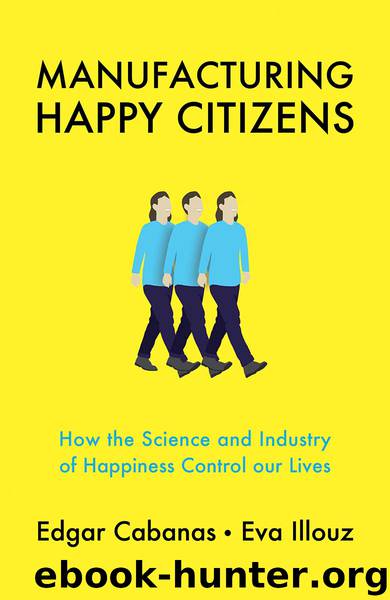Manufacturing Happy Citizens by Edgar Cabanas;Eva Illouz; & Eva Illouz

Author:Edgar Cabanas;Eva Illouz; & Eva Illouz
Language: eng
Format: epub
ISBN: 9781509537907
Publisher: John Wiley & Sons, Inc.
Published: 2019-09-09T00:00:00+00:00
Inverting the ‘Pyramid of Needs’, or how happiness is now required to succeed
The ubiquitous use of the modern notion of happiness in the labour sphere should be regarded as one step forward in the process of managing workers’ behaviour in terms of their psyche.17 From the 1960s onwards, the psychological language of emotions, creativity, cognitive flexibility, self-control, etc. has progressively functioned as an effective way to palliate the structural deficits in recognition as well as the inherent paradoxes and contradictions that are characteristic of modern workplaces. Psychology has gradually made illegitimate the evaluation of workers’ performance in terms of moral categories, providing instead a more neutral and scientific framework to reconceptualize workers’ failures or successes in terms of their own ‘deficient’ or ‘optimal’ selves, and teaching people to cope with the burden of the risk of uncertain and competitive workplaces in terms of their personal autonomy and flexibility. In other words, the psychological language has made the devolution to workers of individual responsibility for the structural deficits of the work-place more and more possible. The modern notion of happiness takes this trend even further in encouraging the widespread assumption that if individuals work hard on themselves, they will overcome performance problems and find their way in the world of labour. One of the most distinctive contributions of positive psychology to this matter has been not the dismissal of Maslow’s ‘Pyramid of Needs’, but its inversion.18
So far, managers, economists and psychologists have generated a vast scientific literature in which they relate workplace success to personal satisfaction, assuming the broadly accepted idea that a worker is happy because she or he is successful. Accordingly, successful outcomes produced happiness and satisfaction, and the claimed high correlation between both variables allowed taking the former as a reliable criterion to assess the latter. Both managers and human resources personnel were mainly concerned with the study of those working conditions – e.g., cooperative vs competitive work, communicative patterns, leadership and supervision, reward/punishment systems, job enlargement, systems of participation and recognition, etc. – and with the identification of those individual traits – e.g., extroverted vs introverted personality, high vs low IQ, achievement vs affiliative motivation, etc. – that were related to the enhancement of job performance and, as a consequence, that provided personal satisfaction. Although in the 1990s managers and psychologists started to suggest that the relationship between happiness and performance could be bidirectional, in most cases organizational studies still understood happiness as something derivate from optimum working conditions and/or high job performance.19 Over the last decade, however, positive psychologists have contested this assumption, asserting that the relationship between happiness and success at work should be better understood in the reverse direction. Happiness scientists claim that ‘past research’, which ‘demonstrated a relationship between happiness and workplace success’, nevertheless failed to grasp the ‘correct’ causality between success and happiness, namely, ‘that happiness is not only correlated with workplace success but that happiness […] is an important precursor and determinant of career success’.20
Allegedly, happy workers are higher-performing and more productive.
Download
This site does not store any files on its server. We only index and link to content provided by other sites. Please contact the content providers to delete copyright contents if any and email us, we'll remove relevant links or contents immediately.
| Coloring Books for Grown-Ups | Humor |
| Movies | Performing Arts |
| Pop Culture | Puzzles & Games |
| Radio | Sheet Music & Scores |
| Television | Trivia & Fun Facts |
Everybody Lies by Seth Stephens-Davidowitz(1631)
You're Not Listening by Kate Murphy(1450)
Sex, Drugs, and Cocoa Puffs by Chuck Klosterman(1217)
Empire of Illusion by Chris Hedges(1172)
The American Scene by Henry James(1169)
The Attention Merchants by Tim Wu(1162)
Simulacra and Simulation by Jean Baudrillard(1138)
The House of Kennedy by James Patterson(1028)
Sense of Wonder by Bill Schelly(989)
Predictably Irrational by Dan Ariely(953)
The 50th Law by 50 Cent & Robert Greene(934)
Fast Food Nation by Eric Schlosser(931)
Free Women, Free Men by Camille Paglia(916)
What the Dog Saw: And Other Adventures by Malcolm Gladwell(840)
At Home by Bill Bryson(822)
Time Travel by James Gleick(814)
North Korea's Hidden Revolution by Jieun Baek(806)
Thank You for Arguing (Revised and Updated) by Jay Heinrichs(799)
Need to Know by Timothy Good(789)
